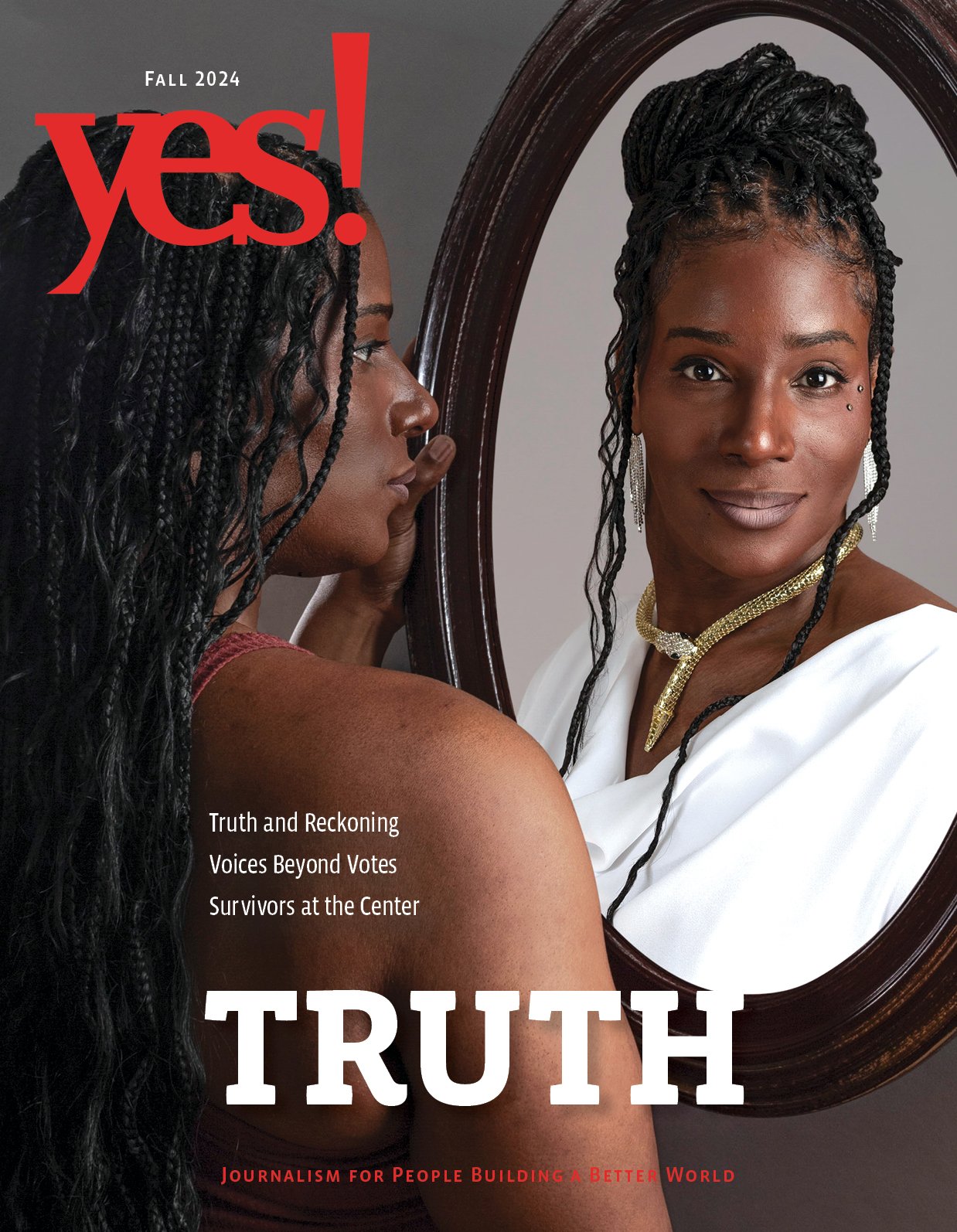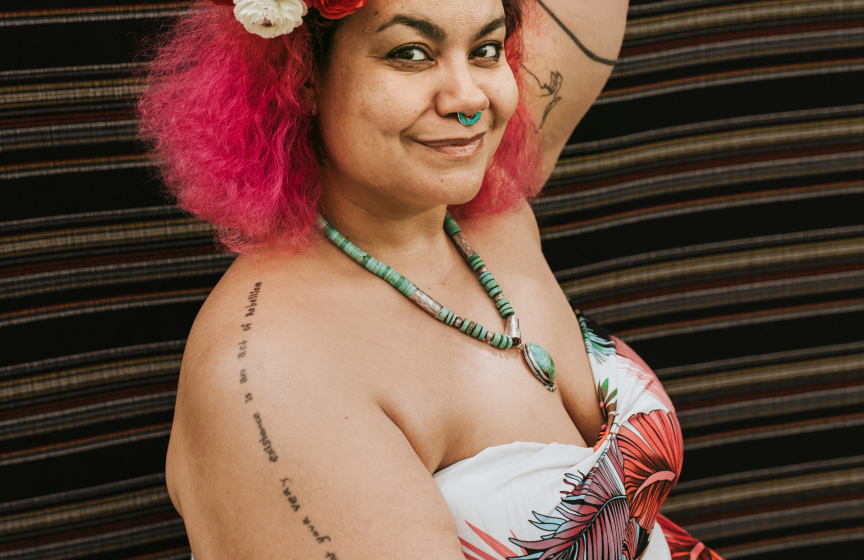Pleasure: In Depth
- Finding Freedom in Black BDSM
- Share

Finding Freedom in Black BDSM
Black kink is about pleasure first and foremost. But it’s also bound up with freedom and empowerment.
Having ownership over your body and sexuality is extremely difficult when you are a girl or woman. It’s even harder when you’re Black. When you’re a fat Black woman, you’re made to feel like your body is an inconvenience and your sexuality is nonexistent.
The dominant, white supremacist, sexist society in the United States has long insisted that Black women’s and girls’ bodies and sexualities don’t belong to us. Since chattel slavery, Black bodies—and especially Black women’s bodies—have been seen as a commodity to be used and manipulated for the benefit of others.
In the absence of cultural models or language that affirmed the possibility of sexual pleasure and autonomy for Black women, we both found that our sexual awakenings were informed by pop culture—whether through soft porn on Cinemax (better known as “Skin-e-max”), Showtime After Dark, or HBO’s Real Sex. One particularly impactful episode of Real Sex featured a Dominatrix. She was powerful. Commanding. She was well-compensated for the work she was doing. She was sexy, fierce, and in control. And, like most depictions of professional Dominants then and still, she was white.
In other words, at the same time that we learned about the possibilities of sex outside of societally accepted norms, we learned that those practices were, with few exceptions, for white people. So even as we both began to explore our own sexual freedom, it would be many years before either of us understood that what we were into was, in fact, kink. It took even longer to recognize that some of those desires were clear practices and tenets of a specific sexual power play known as BDSM (bondage, dominance, discipline, submission, sadism, and masochism). Today, we know that the way we practice BDSM is inextricably connected to our politics and deep longing for Black freedom and autonomy.
More than two decades after first watching that Real Sex episode, conversations with other Black folks have made it clear that kinky sex is definitely not a “white thing.” Black people are (and have been) having kinky sex and exploring BDSM, and, like us, they were finding freedom in the process.
In our communities of Black folks, kinky people were finding one another and creating enclaves of communal practice. Inside these Black kinky communities, we found Black people rejecting white dominant culture’s proscriptions on who was worthy of sexual pleasure, who could rule inside the bedroom, or what it meant to powerfully submit. Here we saw Black people using sex and sexuality as a medium to create new realities and praxes, even for those of us at the furthest margins of society.
Black kink is about freedom and empowerment, but most of all, it’s about pleasure.
“I believe kink is an invitation to revel in difference, to celebrate and extol the virtues and pleasures of that which the mainstream has called ‘deviant,’” says author Sonya Renee Taylor. “Consequently, kink can be a space of possibility and reclamation where fat folks, disabled folks, Black people, [or] those whose bodies have been labeled deviant might go to find themselves desired, celebrated, and even worshipped for their defiant, glorious bodies. And it is these people, in these bodies, who most often need a refuge where they get to be the authors and agents of their own pleasure, pain, joy, and delight.”
When practiced by Black folks outside the gaze of whiteness, heterosexuality, and maleness, Black kink—in particular BDSM—offers opportunities for Black folks to create alternate realities.
Black kink was and is the sexual practice that Black folks deserve. It’s a tool for practicing other ways of being with one another, including an embodiment of consent, grounded conflict transformation, gender liberation, and embodied joy. When practiced by Black folks outside the gaze of whiteness, heterosexuality, and maleness, Black kink—in particular BDSM—offers opportunities for Black folks to create alternate realities. Whether as Dominants (D-types) or submissives (s-types), Black folks’ practice of BDSM is inherently subversive, and offers a medium by which we can shift our relationship and understanding to power and redefine who we are as people and as sexual beings. It can allow us to work through traumas and cleanse the residue that racial, sexual, fatphobic, gender-based, and other forms of oppression have left on us.
At its core, BDSM is a sexual practice about intentional, exaggerated power play. Terms like Master, slave, Dominant, Goddess, pet, bitch, and slut are all regular parts of the lexicon. Consider how consent makes all the difference between being called a “stupid slut” while walking down the street, and being called the same name in the course of a scene (a pre-negotiated, planned BDSM interaction). Degradation is a common BDSM dynamic, and is rooted in the submissive’s connection between their own arousal or pleasure and that practice. If a woman in a scene is being called a “good little whore,” it’s likely because that’s what she has asked to be called. It is equally likely that she has set clear boundaries around what she does not want to be called, what sorts of degradation are off limits for her, and how both she and her Dominant know when the scene is over.
Black folks’ relationship with power, our history with bondage and forced subjugation, and our history of “kinking” practices as a means of experiencing freedom (think of portraits of Black Jesus with dreadlocks, or the use of Negro spirituals and song to communicate during enslavement) mean that our very existence—especially our joy—is subversive. So when we practice kink, we are relating to one another—and to our own bodies and sexual desires—in ways that intentionally seek to buck the status quo.
In a world where far too few Black people get to experience the agency to truly decide what happens to and with our bodies, Black kink offers us space where our ‘no’ is respected and our pain is seen and affirmed.
In a world where far too few Black people get to experience the agency to truly decide what happens to and with our bodies, Black kink offers us space where our “no” is respected and our pain is seen and affirmed. It allows us to choose how we relate to tools like floggers, whips, collars, leashes, ropes, and restraints. We get to choose to reclaim our relationship to bondage, being hit, or being degraded. We get to choose not to be degraded or hurt at all, but rather affirmed and reminded of exactly who we are, using tools like latex dildo gloves. We get to decide that there can be pleasure in pain, freedom in bondage, and power in submission. The difference here is consent.
This understanding of consent—as well as the powerful choice to be submissive—is key to understanding any true practice of BDSM. Despite dominant cultural narratives (which included, until recently, the Diagnostic and Statistical Manual of Mental Disorders) that suggest BDSM and kink are unethical, problematic pathologies, our lived experiences demonstrate the opposite. BDSM is inherently ethical because it is explicitly consensual—a concept that has yet to be fully embraced by the dominant sexual culture.
“Many people come to the [kink] lifestyle because they can find access to care, connection, community, bodily autonomy, empowerment, acceptance, and most of all, pleasure in ways they cannot access in other parts of their lives,” says licensed psychologist Nikki Coleman, Ph.D. “These experiences in and of themselves are healing.”
There is a divide in medical and therapeutic communities about whether BDSM is actually a healing modality or a vehicle for retraumatization. But as kink grows in popularity, and as kinksters from marginalized identities enter into psychology and other emotional and behavioral health fields, there are increasing numbers of safe spaces for kinky people to process some of their traumas outside the sex dungeon. The National Coalition for Sexual Freedom boasts a robust list of kink-positive, non-pathologizing mental health professionals for kinksters looking to heal and contextualize their desires.
“Engaging safely in kink/BDSM play requires a level of trust in self and others and a sense of worth within specific boundaries all wrapped up in pleasure and fun,” Coleman continues. “In addition, the experience of engaging in kinky play can rewire or amplify certain brain–body neural pathways that create a sense of safety and joy that contributes to a person’s psychological functioning.”
No matter how we enter Black kink, our inherent value and worth are seen and understood in those spaces. There is a deep level of intentionality within Black kink spaces, which by its nature is antithetical to the status quo, even within the broader kink community (which is dominated by white people).
“I feel infinitely more cared for, especially as an s-type,” within exclusively Black kink spaces, says Sphinx Thee Minx, a Black BDSM practitioner. “I feel like there’s more room for us to expand into our roles, rather than getting retrofitted into a role that doesn’t work.”
Black kink makes room for Black people in ways that do not feel forced, and in ways that offer opportunities to build connections and dynamics that allow for exploration, while also facilitating communal practices of keeping one another safe. Respect, boundaries, and consent are key tenets of Black kink—and kink more broadly. Members of the community regularly echo the refrain that all participation needs to be “safe, sane, and consensual.”
“I feel the love and energy for what we do is different in Black spaces,” says Mx. Tyesha Best, a Black nonbinary writer and leader in the leather community. “We understand quite clearly the sexual freedoms [we have] that many of our ancestors were not afforded. We take ownership and pride of our bodies differently because it is empowering for us to choose how and when our bodies are displayed and celebrated. It is an act of rebellion for Black people to have the sexual freedoms that we have.”
Black kink is necessarily intersectional, as we cannot extricate our own multitudes. As fat Black women who play respective roles of submissive and Dominant, the experience of all-Black or multiracial kink spaces is one where our manifold identities are not just accepted, but welcomed. Desired. Fat bodies, disabled bodies, gender-bending bodies are not just accepted, but welcomed. Desired. This is perhaps the most freeing experience that BDSM offers.
Sex worker Bodacious Beautee has likewise found affirmation in Black kink spaces. “I know who I am in this lifestyle, and I’m on a mission to show what can be done as a sexy disabled woman in kink,” she says. “Having cerebral palsy on the right side of my body limits me in some ways physically, but that shouldn’t limit my ability to feel sexy and empowered. In my kink community and in this newfound space of strength and liberation, it makes me feel [as] sexy with my ankle brace on as if I’m wearing my collar as a submissive with my Dominant’s name plastered across in bold gold letters.”
Blackness and Black people have been redefining and leading cultural change for as long as we have existed. Our practice of kink and BDSM is no different. Black kink is a liberatory practice—it is church and sanctuary. It holds lessons for how we show up outside of our play spaces, and also for how non-Black people can integrate a praxis of anti-racism even in their pleasure practices.
|
Kharyshi Wiginton
is a wildish natured woman, a sensual siren, submissive sex goddess, passionate pleasure pussycat, and a sorceress weaving a world of magic with her art.
|

